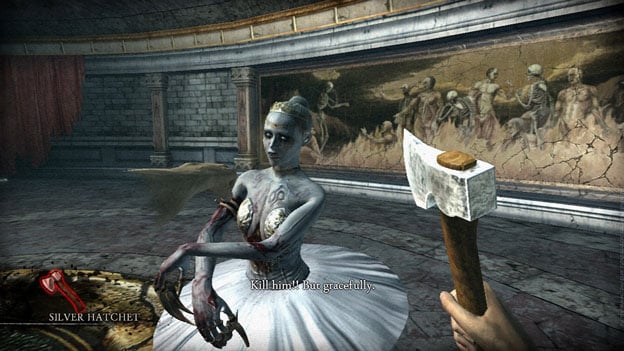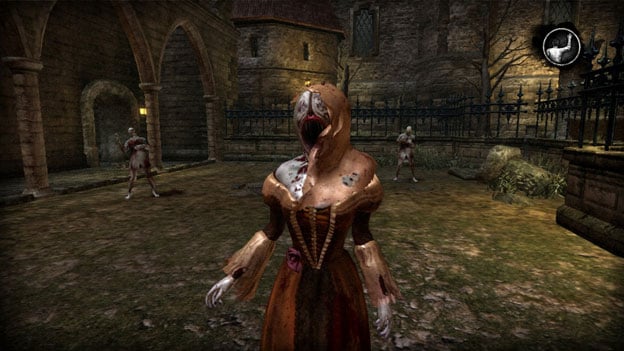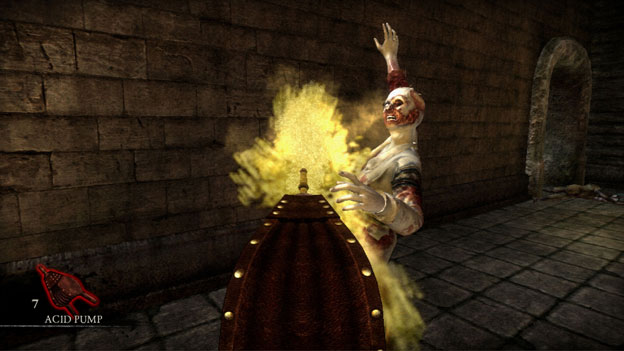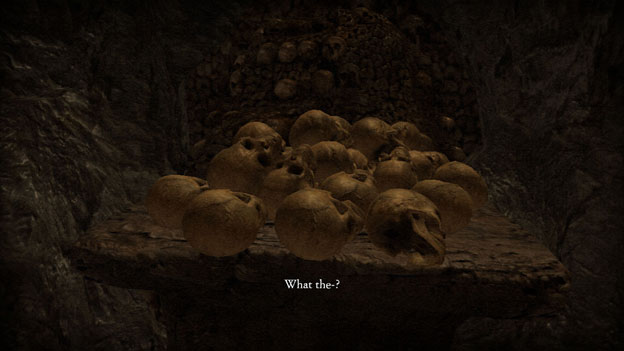A Nightmare You Can Forget
The horror game experience is one that just about all gamers are familiar with. Playing in the dead of night, lights off, with the volume turned up is a sure-fire way to get into a horror game. Unfortunately, you cannot play Rise of nightmares this way. You need the lights on, the sound can’t be too loud (Kinect doesn’t like audio feedback), and you need to stand as far away as possible so the unit can see you. The experience feels different than anything else from the onset, and that could have been a good thing. By isolating you in your home, away from the safety of a comfy chair or a video game controller, Rise of Nightmares could have delivered a unique experience. However, some poor design choices and mechanics make Rise of Nightmares nothing more than a missed opportunity.

When the game begins, you are stuck in a pretty generic jail cell with a standard-issue screaming girl. Apparently, everyone’s dead and there are monsters, and then—oh wait—you just got turned into strawberry jam. How did this happen? Well, you’ll get to experience one of the most overused B-movie tropes ever and go back in time to before everything went wrong. You play as Josh, who is a bad husband. He has a drinking problem, and his wife can’t deal with him anymore. Then she gets kidnapped by an evil scientist who experiments on corpses. So you have to overcome your addiction to the bottle and save her. Yep, it’s that kind of a story.
However, having a shallow story is no huge crime in the survival horror genre. Not every game can be a BioShock or a Silent Hill. But the problem here is that there isn’t anything to make you really want to keep playing the game. Monsters are generic-looking, single-note characters come and go without incident, and there are never any big developments or twists in the story. And when there’s nothing to draw you in, it is hard to justify sticking around for more than just the first act or two. But you might wonder if perhaps the gameplay might justify the poor storytelling. Here’s a spoiler-alert for you: it doesn’t.

I am all for “Mature”-feeling Kinect games. But when you try and shoehorn adult content into what feels like it could have been a point-and-click adventure, you’ve got a very serious problem. The format of the game shuffles you from room to room in a house of horrors, and you’ll have to flick your hands to open doors, pump your arms to run away, or flail your extremities Fruit Ninja-style to kill enemies.
Though the interface feels incredibly immature, if you take it for just what it is, the experience isn’t terribly offensive. However, the real problem starts when you try to move. The game has a very convoluted movement system, having you turn your shoulders either left or right and lift one foot to move. This system is far from precise, and controlling your character is a challenge indeed. Just going in a straight line (the most basic of all in-game actions) is much more difficult than it needs to be, and can be frustrating when you spy a weapon to pick up and can’t get over to it because you can’t get your shoulders and foot to work in tandem. The only saving grace here is an “auto-movement” system that will take you automatically from enemy area to enemy area with a simple raise of the hand. This limits your ability to explore your surroundings, but aside from finding weapons, there isn’t anything to explore in the halls of this nightmarish castle.

And while we’re talking about the environment, let’s talk visuals. If you were wondering if this game would finally be the Kinect title that would include the awesome visuals we’ve grown accustomed to from current-generation game, you can think again. The castle itself is horribly bland, and the screen is often devoid of anything besides a monster or two and some repetitive textures. Even the monsters look bad, as most are poorly designed and have very repetitive animations. Scary games are all about atmosphere, and unfortunately, Rise of Nightmares has none.

Sound doesn’t really help matters either, as Rise of Nightmares has one of the worst audio design schemes I can recall. The background music can best be described as grating, as it is generally just made up of loud noises and agitating sound effects. When you pair that with a frustrating control experience, the combination is enough to make you want to throw an invisible controller. Though the voice acting isn’t terrible (depending on your tolerance for bad foreign accents) the music sent me over the edge in a hurry, cementing the experience as something horrifying (and not in the way originally intended).
In fact, that idea just basically sums up the Rise of Nightmares experience as a whole. The game is scary, but only because it plays so poorly. Though I still like the idea of Rise of Nightmares, the finished product isn’t something that I can see any gamer getting excited about. The poor control mechanics and broken movement system already make the game practically unplayable, and when you add it to poor production values and a story that it is incredibly hard to care about (it’s not even funny in a bad way), then you’ve got a Kinect game you should stay away from. Sure, you don’t have to heed my warning, but doesn’t one of the standard horror tropes state that the first victim always gets ample notice? Don’t be that first victim. Leave this game on the shelf.
RATING OUT OF 5 RATING DESCRIPTION 2.3 Graphics
Visuals are bland and basic. Animation is repetitive. 2.5 Control
While there are moments where the control works, movement is a continual issue and wrecks the entire experience. 2.3 Music / Sound FX / Voice Acting
Voiceovers aren’t terrible, but the music is grating. 2.5 Play Value
If you get through it once, you won’t want to re-live the experience. 2.3 Overall Rating – Poor
Not an average. See Rating legend below for a final score breakdown.
| Review Rating Legend | |||
|---|---|---|---|
| 0.1 – 1.9 = Avoid | 2.5 – 2.9 = Average | 3.5 – 3.9 = Good | 4.5 – 4.9 = Must Buy |
| 2.0 – 2.4 = Poor | 3.0 – 3.4 = Fair | 4.0 – 4.4 = Great | 5.0 = The Best |
Game Features:
